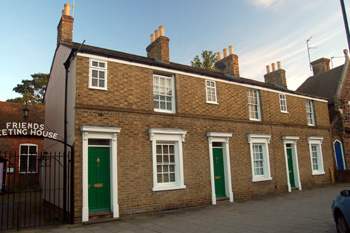27 to 31 North Street Leighton Buzzard

27-31 North Street June 2008
The Manor of Leighton Buzzard alias Grovebury was the principal landowner in the town before the 19th century. Bedfordshire & Luton Archives & Records Service has a full run of court rolls from 1393 to 1727 [KK619-715] and another full run from 1704 to 1867 [X288/1-23]. The service also has court rolls for other manor to own land in the town, the Prebendal Manor, from 1448 to 1459, 1588 to 1591, 1611 to 1622, 1627 and 1631 [KK792-1798]. A fair number of buildings in the Market Square were originally copyhold and a detailed study of these court rolls would probably produce quite detailed histories for a number of properties and the sites on which they stand, though it would take many years of study.
27, 29 and 31 North Street were listed by the former Department of Environment in 1975 as Grade II, of special interest. They date from the early 19th century and are built of yellow brick with a Welsh slated roof. They comprise two storeys. Benjamin Bevan published a map of Leighton Buzzard in 1819; two years later a reference book was published giving owners and occupiers of every property shown on his map. It is not known whether, at that date, the buildings on the site were today's 27-31 or its predecessors, though the footprints of the buildings do appear to be identical. They were all owned by J. Grant and occupied, respectively, by J. Church, W. Dawson and M. Hawgood.
Under the terms of the Rating and Valuation Act 1925 every piece of land and building in the country was assessed to determine the rates to be paid on them. Leighton Buzzard was assessed in 1927 and the valuer visiting the three properties [DV1/R74/34] found that they were identical. The row was owned by the Society of Friends (whose meeting house is partially behind the row) and 27 was occupied by Mrs. Phyllis Griffin as a recipient of Hannah Grant's Charity at a rent of four shillings per week. 29 was occupied by Joseph Pratt and 31 by Frederick Hall both at the same rent as Phyllis Griffin. Each house contained a parlour and kitchen downstairs with two bedrooms above. Each house had a cellar and a W. C. in the yard.
By 1959 the houses were in such a poor state that little more than a shell remained. The Society of Friends was advised bu commercial valuers that the most cost effective solution would be to demolish them (they were not yet listed buildings). Thankfully for posterity the Quakers took a more enlightened view of their heritage and, over the next few years, renovated the properties with the help of grants making them once more fit for human habitation [FR/24/14/21].